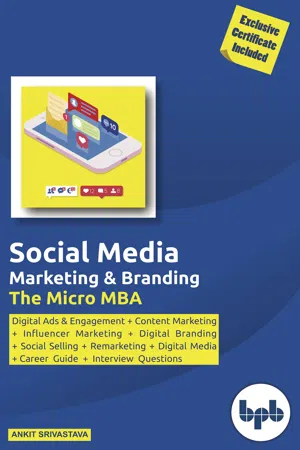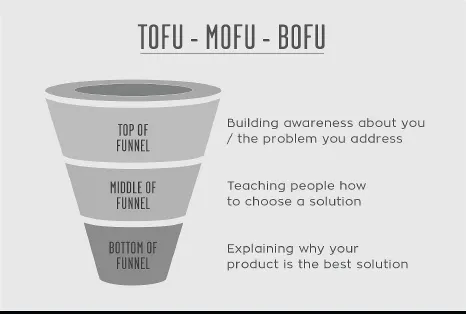
- English
- ePUB (mobile friendly)
- Available on iOS & Android
About This Book
The Micro MBA Key Features Complete this book to earn an exclusive certificate in "Digital Campaign Design" and "Social Media Marketing"Prepare for Social Media Certification from Facebook, Twitter and moreDigital Marketing Career Guide Included Free Resume templates45 Digitally Interactive Chapters 20+ Case Studies160+ Chapter-wise Interview QuestionsBecome Job ready in 4-weeks! Description Before you invest your time in this book, you should find the answers to the following questions;How can this book help you get a job? Why not study online? Why this book?Social Media Marketing and Digital Branding are one of the top 15 in-demand skills for getting a job in 2019-20, along with Content Marketing and Influencer Marketing. A complete module is dedicated to getting you a job. In this book, you'll get a Career Guide for Digital Marketing Jobs, CV templates, Chapter-Wise Interview Questions, and a Guide on Personal Branding for getting better jobs. Completing this book will get you an exclusive certificate in Digital Campaign Design and will prepare you to directly appear for Facebook™, Twitter™, Hootsuite™ and HubSpot™ certifications. While most online course and blogs concentrate on quick tips to use digital tools and platforms. What will you learn Book has 45 easy to grasp chapters grouped into 13 interactive modules dedicated to teaching you the step by step process of using digital platforms to develop successful marketing campaigns using effective advertising strategies based on consumer behaviour, segmentation, positioning, brand management, and the customer lifecycle. Live link case studies and process guides have been included for a hands-on learning experience. Who this book is for You could be a student, a fresh graduate, or a working professional with any educational background and you will be able to start your career in digital marketing with the help of this book. Table of Contents Social Media Marketing for Each Step of the Digital Customer's Life CycleThe Digital Customer Life CyclePhases and Stages of the Customer Experience FunnelDigital Ads (Part 1)Programmatic and Real Time Digital Ad Buying (How Digital Ads Work)Programmatic Bidding for ADS on FacebookSetting up A Facebook & Instagram Ad CampaignFacebook Ad TypesCreating Facebook Ad's Creative and CopyAd Reporting and OptimizationSegmentationConvectional SegmentationSegmenting Audience with FacebookRemarketing with Facebook's Custom AudienceDigital Behavioral Segmentation Using Custom AudienceCreating Buyer PersonasDigital Value and Marketing MessageUnique Digital Value PropositionPerceived Benefits, Hassel Factor, and Means End Theory for Crafting A Marketing MessageDesigning a Unique Digital Value PropositionDigital Media and EngagementPaid, Earned, and Owned MediaSocial Media EngagementContent Marketing for Social Engagement and Story TellingContent MarketingUser-Generated ContentTransmedia StorytellingDigital Influence Driven MarketingDigital InfluenceInfluencer MarketingUI, UX, CX, and BX for Digital MarketingUnderstanding UI, UX, CX and BXCX and UX for Social MediaDigital Brand Experience and ManagementDigital BrandingBrand Promotors and DetractorsSocial Listening, Selling, Care, and CrisisSocial ListeningSocial SellingSocial Media for Customer Service, Support, and DelightSetting Up Social Customer CareManaging a Social Media CrisisAgile Testing for Social MediaA/B TestingA/B Testing Facebook Ad CampaignsDigital Ads (Part 2)Linkedin Ad CampaignsInstagram Story AdsSnapchat AdsTwitter AdsAdvertising on Pinterest, Quora, and RedditGDPR, Budgeting, and Behavioral PsychologyDigital Career GuideA Repository of Campaign Case StudiesJob GuideResume Tips and Linkedin for JobsChapter-wise Interview QuestionsCertifications. About the Author Ankit Srivastava is a certified Digital Marketer, a Digital Branding and Social Selling Trainer, a TEDx speaker and works as a Digital Growth Strategist.
Frequently asked questions
Information

CHAPTER 1
The Digital Customer Life Cycle
Pre-Digital Marketing/Sales Funnel


- The assumption that a digital customer’s journey is linear
- Not acknowledging the fact that a customer can enter the journey at any stage
- The lack of detailed attention to each stage of the funnel
- The lack of a consistent strategy throughout the funnel phases
- Not accounting for the fact that the customer’s decisions are Affected by external influences
- The lack of commitment to the customer’s experience beyond the point-of-purchase

Re-Engineering the Funnel
Suspects
Prospects
Leads
Customer (Buyer)
Consumer (User)
The Customer Experience Funnel

- Like the product (Adoption)
- Become accustomed the brand (Retention)
- Buy more products from the brand (Amplification)
- Spread positive awareness about the brand (Advocacy)
Conclusion
CHAPTER 2
Phases and Stages of the Customer Experience Funnel
Table of contents
- Cover
- Social Media Marketing & Branding
- Copyright
- Preface
- Acknowledgements
- Introduction - The Social Consumer
- Contents
- Module 1: Social Media Marketing for Each Step of the Digital Customer’s Life Cycle